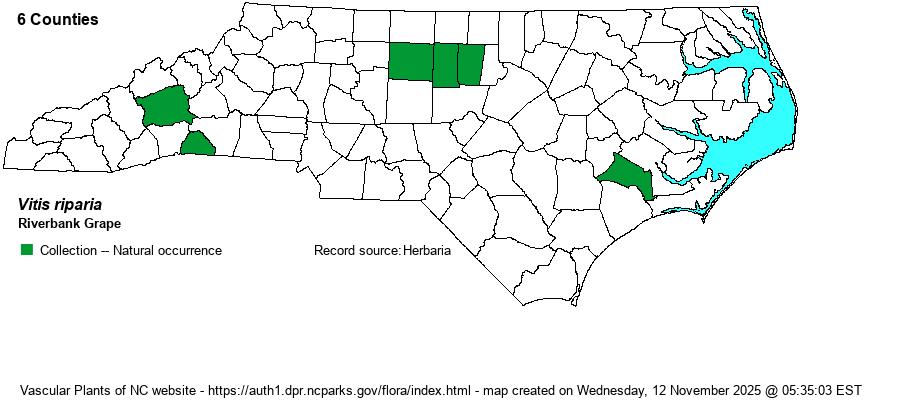| Author | Michaux | |
| Distribution | The most poorly known grape in the state, with records only for a few counties in the northeastern Piedmont, the southern Mountains, and one in the eastern Coastal Plain (Jones). As it occurs over much of VA and has been found in many border counties with NC, even in their Coastal Plain, perhaps the species is being overlooked, at least in the Coastal Plain.
This is a Northern and Midwestern species that ranges widely, from southern Canada to most of VA, and west to the base of the Rockies. It does occur well into TX and east to MS, TN, and NC. There are no known records for SC, GA, AL, and FL.
| |
| Abundance | Very rare to rare and poorly known in the state. Should occur in counties bordering VA, where it would likely be rare. Despite it being known from just 6 counties, it is not on the NC NHP’s Watch List, perhaps owing to difficulty in identification, or simply by being overlooked; it is suspected that many biologists do not bother with grape identification. It definitely should be placed on the Watch List, if not considered as Significantly Rare. The S2? state rank was provided by editors of this website, as the NC NHP has not yet assigned a state rank. | |
| Habitat | In NC, this species is presumed to occur mainly along larger rivers or other creeks and rivers with high pH soil, such as rich bottomlands and natural levee forests. It seems to favor banks of such waters, as the common name implies. |
| Phenology | Flowers from April to June, and fruits from August to September. | |
| Identification | This is still another high-climbing, deciduous woody vine, normally found close to rivers and larger creeks. The leaves are similar to others in being mostly three-lobed but only about 4-5 inches long and wide, generally smaller than on other Vitis species in the state. Weakley (2024) even says that it "Can be mistaken for Ampelopsis glandulosa." The leaves tend to have cordate bases with a rounded sinus, as opposed to sharply cordate with a pointed sinus. The leaves are typically glabrous and thus reasonably smooth and green below; in addition, they tend to be somewhat shiny looking on both sides. The branchlets are often smooth. Tendrils are present opposite most of the nodes, but in general, identify this scarce species (in the state) by its fairly shiny and glabrous leaves (generally smaller than others) and twigs. | |
| Taxonomic Comments | None
Owing to difficulty of identification of nearly all Vitis species from photographs, for now no iNaturalist photo reports are included on the range maps. In fact, very few of these have been given a Research Grade status of approval by an expert. | |
| Other Common Name(s) | River Grape, Frost Grape (an incorrect name, as this name is generally used for V. vulpina). | |
| State Rank | [S2?] * | |
| Global Rank | G5 | |
| State Status | | |
| US Status | | |
| USACE-agcp | FACW link |
| USACE-emp | FACW link |

